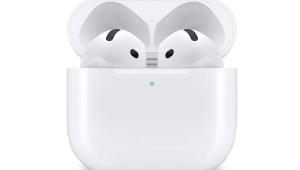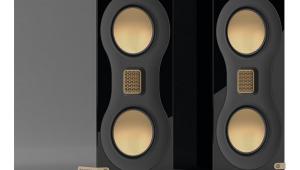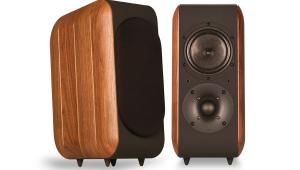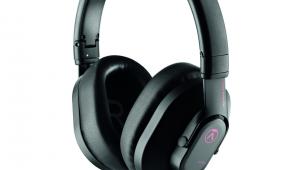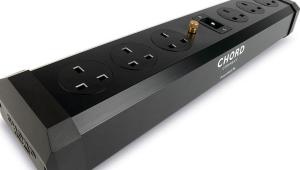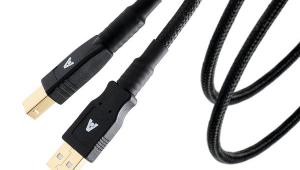Audiolab 8300 Series
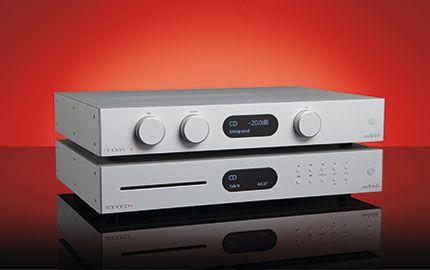
Launched in October 1983, Audiolab’s original 8000A integrated amplifier was a veritable powerhouse by the standards of the day, with a quoted 50W RMS per channel into 8ohm that virtually doubled into 4ohm. Remarkably, unlike nearly all its rivals, the 8000A could even work into 2ohm loads without going bang. The model was extensively tweaked over the years and by the nineties had become a sort of hi-fi version of the Volkswagen Golf – affordable yet designed and engineered like no others at the price. It lived on for 14 years in its original incarnation, and the 8300A you see here is its latest descendant and arguably most radical departure. It has been substantially redesigned inside by Jan Ertner, and can function either as an integrated, preamplifier or power amplifier.
The new version uses four bipolar output transistors per channel running in Class AB to give a claimed 75W per channel (into 8ohm, 105W into 4ohm) with a maximum current delivery of 15 amps into difficult loads. The designer says its power amp output stage uses a special complementary feedback topology for linearity and thermal stability, with the idle current kept independent of the temperature of the output transistors. Having the emitter follower deliver additional current only when needed means that Audiolab’s Active Current Drive system can be used, where a microprocessor controller lets the amp supply high currents (+/- 15A) into complex loads if need be. A 300VA toroidal transformer supplies the two mono amplifiers using separate secondary windings, followed by 2x 15,000uF reservoir capacity per channel (60000uF in total).
Built with care
Topologically, the 8300A has been designed to keep the preamp section away from as much noise as possible. It also sports a built-in phono stage, said to have been designed “with care” and featuring MM and MC inputs. Also new is a fascia-mounted OLED display showing volume level, input selection, mode of operation and MM/MC phono setting. The rear has five line-level RCA inputs plus one balanced XLR. Two preamp outputs are fitted, along with a 12V trigger loop and bi-wireable binding posts.
The 8300CD CD player’s lineage doesn’t go back anywhere as far as its stablemate. It’s a light rework of the 8200CD, which appeared in 2011. That’s no bad thing, because it was an excellent machine at the price, and an extremely advanced design. It replaces both preamp-equipped and non preamp-equipped variants of its predecessor (the 8200CDP and 8200CD). It sports a new look and a slot-loading transport mechanism, along with the aforementioned full preamp functionality and an improved USB input (32-bit/384kHz rather than its predecessor’s 24-bit/96kHz). It now offers DSD playback via USB too; there are four extra filters for DSD playback (in addition to the seven filter settings for PCM files inherited from the 8200CD).
The new Audiolab 8300CD also has a balanced XLR analogue output, and AES/EBU digital in; the former is ideal for feeding the new XLR in on the 8300A. With its preamp functionality, you can now configure the 8300A as a power amplifier, and drive it directly from the 8300CD. The latter has all of its predecessor’s rear sockets, including two coaxial and optical digital inputs, upgraded asynchronous USB, single coaxial and optical digital outputs
plus single-ended RCA outs and a 12V trigger loop. The fine aluminium finish is available in silver or black.
Sound quality
The 8200A was a well received amplifier four years ago, and still sounds very respectable now. As you might expect, it has a good deal of the 8000A’s family sound – meaning a tight, taut, crisp character with powerful yet sinewy bass and a strong, well-defined soundstage. In truth, the new 8300A doesn’t divert far from this, bringing a little more power to the table, and a slightly more open and dynamic nature. It seems a little fresher and less introspective; if we’re honest its predecessor could sound a little shut in and mechanical compared with the best of the rest at the price, and there’s less of that sense with this new machine.
I initially run it as an integrated amplifier partnered up to my reference dCS Debussy DAC, yet it doesn’t sound particularly bothered by its exotic companion, serving up a powerful and lively rendition of The Kink’s Village Green Preservation Society. This is a warm and soft recording with a lilting musical feel, and not something the 8200A would automatically sound good with, but the new Audiolab is unfazed and dives into the song with aplomb. You can certainly feel the family character; the 8300A is a long way from being as tonally fulsome as Arcam’s FMJ A39 for example (HFC 394), and won’t flatter a poor recording. Rather, it gives a spry, detailed and distinctly ‘matter of fact’ rendition of what it is asked to play – but that doesn’t mean it’s boring. If the recording is poor it won’t guild the lily so to speak, but still likes to get into the groove and power along the song. There’s still that slight family ‘dryness’ that valve amp fans won’t warm to, but this generation of Audiolab integrated clearly has a commanding nature that is obviously up for fun. The song certainly seems to roll along in a satisfyingly musical way.
Fed by its partnering 8300CD silver disc spinner, I don’t hear quite the drop in fidelity anticipated. The Audiolab CD player is obviously a step or two down from the dCS DAC, but still doesn’t embarrass itself. There’s
a sense that it’s very detailed and intricate sounding, but again – like many digital sources using ESS Sabre DAC chips – has a slightly dry tonality that doesn’t quite run the full spectrum of tonal colour. Still, in other respects you’re quite unprepared for just how good it can sound. For example, Congo Ashanti’s Hail The World Of Jah has a widescreen soundstage and hangs images back surprisingly deeply. Treble seems a little sweeter than its 8200CD predecessor, and there doesn’t seem to be quite as much noise across the midband; its predecessor could appear a little grey and hazy.
Indeed, the new CD player proves quite a surprise. Rhythmically it’s not the snappiest of designs, preferring to give a solid, gently flowing sort of musical presentation rather than a frenziedly energetic one, but its appeal is undeniable. This machine has a confident, authoritative sound that’s a good deal more svelte and composed than most of its rivals.
Feed it some powerful eighties guitar rock, courtesy of The Smiths’ What Difference Does it Make?, and this rather opaque and thin recording comes over with a surprising degree of smoothness and refinement, yet doesn’t sound boring. Again, I am more than a little surprised by this as it seems to have gained subtlety and detail, yet has lost none of its predecessor’s punch.
The unit works very well as a digital preamplifier too, with an excellent USB input that gives nothing away to any price rivals. Hi-res PCM via a MacBook Pro running Audirvana is highly enjoyable, the Audiolab bristling with energy and delivering a wonderfully expansive and polished rendition of Chic’s I Want Your Love at 24/96. The 8300CD is better able to communicate the tonal flavour of the recording than its predecessor, with a fractionally richer and more weighty bass, a subtly less ‘grey’ midband and silkier treble. Yet despite this it remains very satisfying in musical terms, ably showcasing the superb musicianship that’s on this track and its intricate, multi-layered mix. This album certainly isn’t the smoothest around and can sound a tad ‘toppy’ when played back on many rival digital sources, but the Audiolab remains a consummate smoothie throughout the duration of the song.
My experience is that this pairing works fractionally better with the 8300CD working as a preamplifier and the 8300A playing the role of a power amplifier, but it is subtle. Working in the conventional way, however, you can take advantage of its surprisingly capable phono stage. Joan Armatrading’s Love And Affection on vinyl via my Michell GyroDec/Tecno Arm/Lyra turntable is a pleasure. It delivers a noise-free yet gutsy sound with a solid bass, clean and three-dimensional midband and smooth, refined treble. You will do better still if you invest in a good £500 phono stage, but the Audiolab’s isn’t there simply to tick boxes.
Conclusion
The 8300A is an excellent value integrated amplifier that’s an ideal companion to its new CD player and also a fine-sounding product in its own right. Of the two, the 8300CD is the stellar performer, and surely the best-sounding silver disc spinner at the price right now. Not only this, but it is beautifully engineered and feels like the slick piece of design that it is. Both highly recommended, then!
DETAILS
PRODUCT: Audiolab 8300A
Origin: UK/China
Type: Integrated amplifier
Weight: 7.8kg
Dimensions (WxHxD): 444 x 80 x 330mm
FEATURES
Quoted power: 2x 75W (8ohm)
Class AB operation
Inputs: 5x RCA, 1x XLR; 1x MM/MC phono
PRODUCT: Audiolab 8300CD
Origin: UK/China
Type: CD Player/DAC
Weight: 6kg
Dimensions (WxHxD): 444 x 80 x 317mm
FEATURES:
ESS Sabre32 9018 DAC; 32-bit/384kHz PCM, DSD
Switchable digital filtering
Digital inputs: 2x coaxial; 2x optical; 1x USB; 1x AES/EBU
Analogue outputs: 1x stereo RCA; 1x stereo XLR
Slot-loading CD drive
DISTRIBUTOR: IAG
TELEPHONE: 01480 447700
WEBSITE: audiolab.co.uk
 |
Inside this month's issue:
Ruark R610 music system and Sabre-R standmount speakers, PMC twenty.23i Active, floorstanders, English Acoustics Downton preamplifier, Bluesound NODE ICON preamp/streamer, Ortofon Concorde Music Blue MM cartridge and much, much more
|

 Read full review in our
Read full review in our 


























